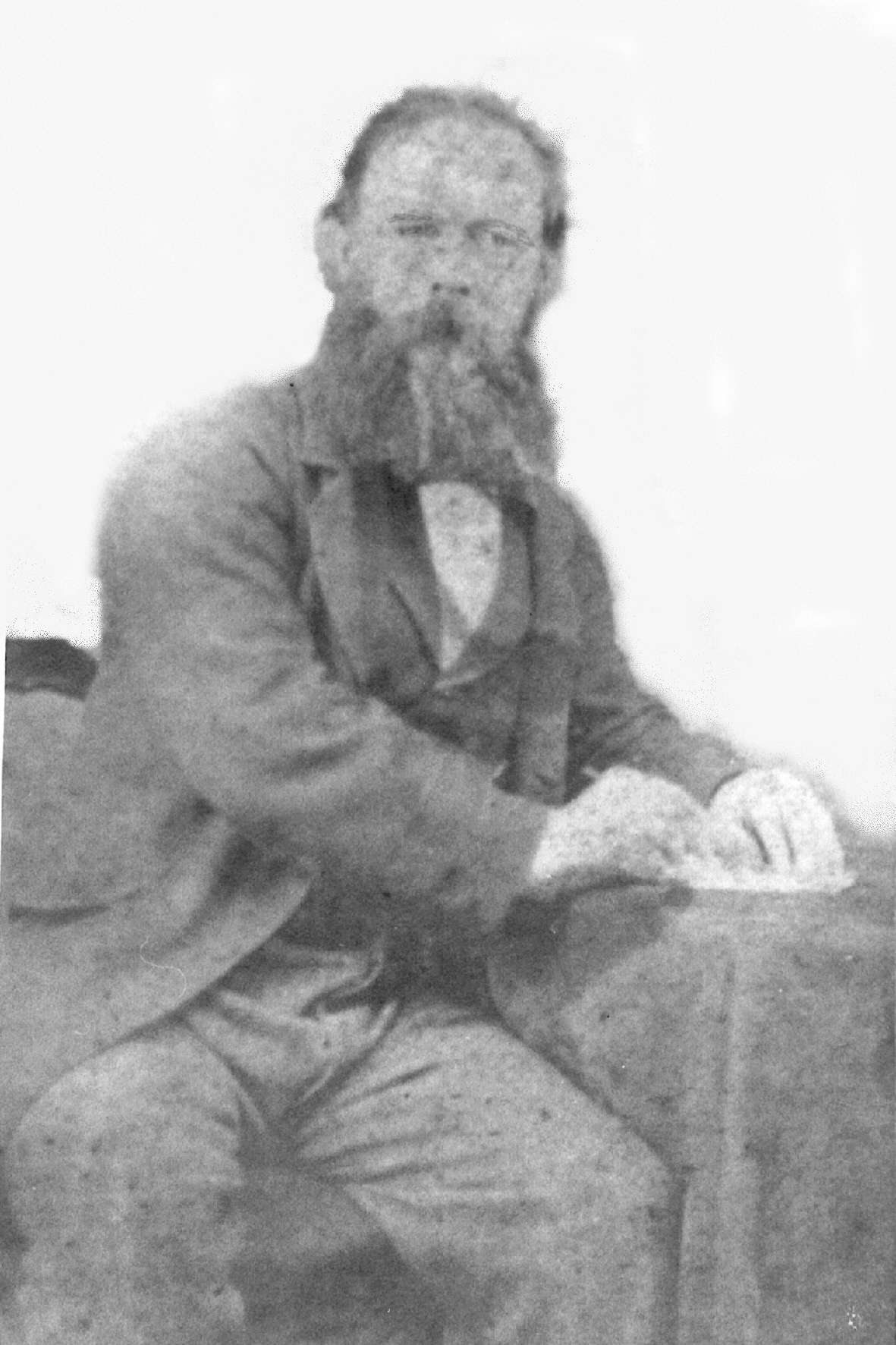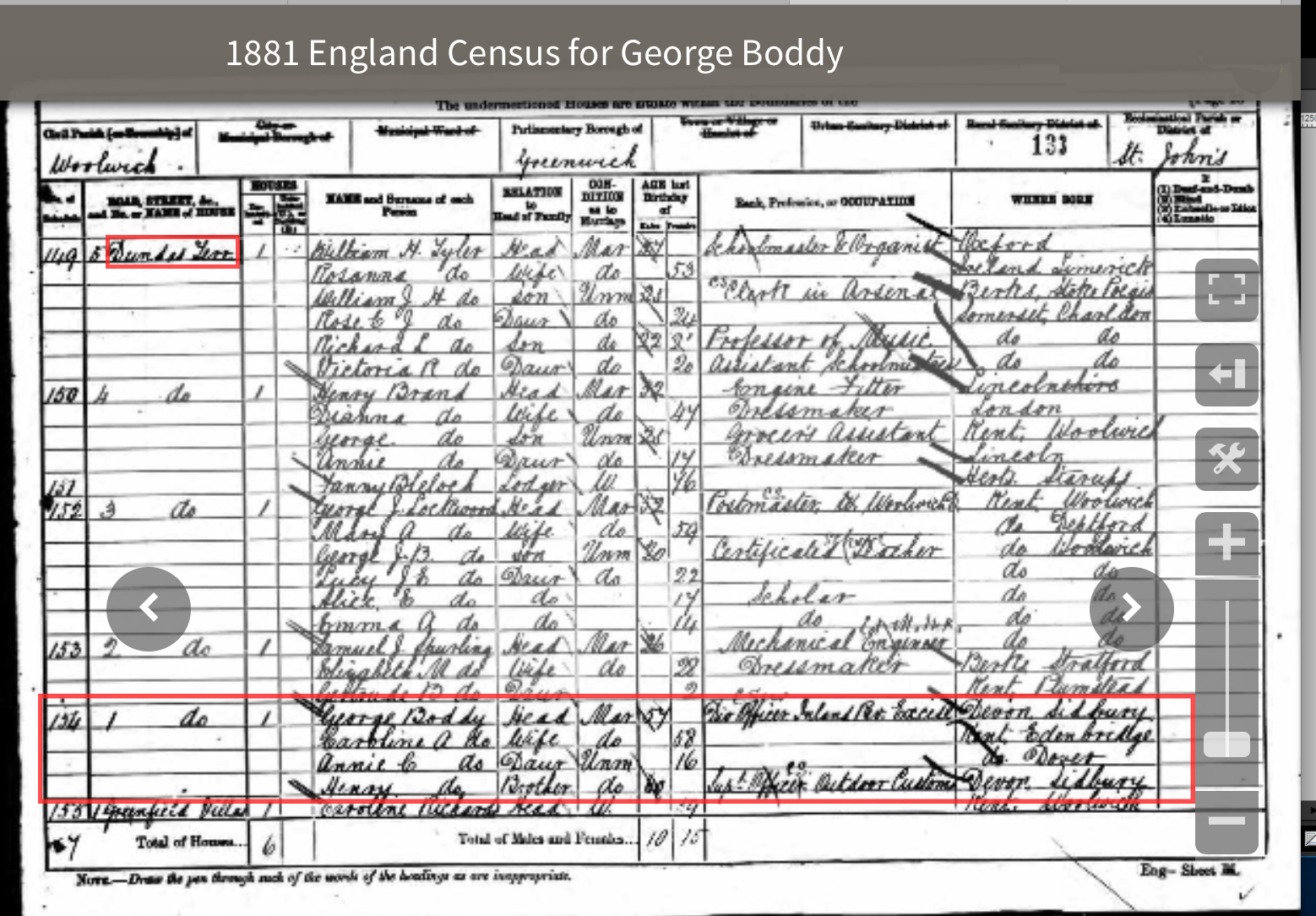
George Boddy (1824-1901)

John Boddy
to Caroline Nicholson
Death:
30 September, 1901 Hamilton (Broadmeadow) NSW

William Henry (1850 - 1924)
Alfred (1853 - 1913)
Charles (1855 - 1927)
Catherine Augusta (1857 - 1925)
Samuel (1859 - 1945)
Annie Charlotte (1864 - 1909 )
George was the earliest generation of our Boddy ancestors to make the daunting trip to Australia - and by the time he arrived in the colony, he was already well into his retirement years. He was brought here in 1888 by one of his sons, Alfred, who had been enticed by the reports from three of George's other children, who all ventured south earlier in the 1880s.
Sidbury in Devon, George's home town and that of his morther Charlotte, was a world away from the new settlement of Newcastle, in New South Wales. He was born in Sidbury in 1824, and probably had his initial schooling in the village, along with his two brothers, Henry and Joses.
In the 1830s, the family left for London, where George's parents, John and Charlotte had married in 1821. While John worked as a parliamentary messenger, the family lived close-by to Westminister. The Civil Service also appealed to young George, and in 1844, when he was 20 years old, he applied to the Inland Revenue Service. His appointment papers are in the National Archives at Kew in London. The five pages relating to his appointment can be read here.
In the 1840s, he met Caroline Nichsolson, the daughter of a shoemaker from Kent. The young couple - George was then 23, Caroline slightly older at 25 - married in April, 1847 at St George the Martyr in Southwark in south London. George set about building his career, as the same time as his family expanded to seven children - five sons and two daughters.
The nature of George's work meant the family moved around southern England, and at each of the subsequent 10-year census conducted by the UK Government, the Boddy family lived in a different address. In 1851, when there were just two young children, George jnr and William, George and Caroline were living at the Staple Hill area of Mangotsfield, in south Gloucester, just north east of Bristol. Two years later, they had moved to South Stoke a small village close to Bath, where their sons Alfred (grandfather of Geoffrey Alfred Boddy) and Charles were born.

South Stoke is an historic village, with its pub dating from 1498, and its church, St James, from the 12th century.
There were at least two more moves ahead of George and his family in his
working life - to Dover in Kent and Andover in Hampshire..
In Dover, the family was living at 11 Dour street in 1864 when the youngest daughter, Annie Charlotte was born. However, that house fell victim toWorld War 11 bombing
The 1871 UK Census shows the family living in a street known as 'The Acre' in Andover, but unfortunately, no street number was recorded. However, in 2019, this (left) is typical of the remaining houses in the The Acre.
By1881, George and Caroline had moved to the capital, closer to their son Alfred in suburban Woolwich.

The 1881 Census (above) shows George and Caroline, with their youngest daughter Annie, and George's brother Henry, at 1 Dundas Terrace in Woolwich. Dundas Terrace is/was a row of terrace houses at 43-50 Brookhill Road:

The Boddys were still living in Dundas Terrace when 65 year old Caroline fell ill with cirrhosis of the liver, dying on Boxing Day 1887.
Her death may have prompted George to join with son Alfred and his family in Alfred's plans to migrate to Australia, where two of George's sons and a daughter were already living. Samuel, Charles and Catherine ("Kitty") had established new roots in Sydney and Newcastle, and had probably sent back glowing reports to the Motherland of life under the Southern Cross. George's three other children, George jnr, William and Annie elected to remain in England - but that changed within just a few years.
George's youngest child, daughter Annie, had married Charles Richards, the son of a publican. Although the young couple had a son, the marriage soon disintegrated, and Annie fell on hard times. "Annie Richards" is a common enough name, so we can't be sure that any reports of misbehaviour, vagrancy and drunkeness (including a stint in Holloway prison) were actually of George's Annie, but within three years of the family's arrival in Australia, George heard about Annie's fall from grace and headed back home to London, presumably to rescue Annie from her misbehaviour.
He planned to return to Australia with Annie and one of his grandchildren, Samuel, son of his oldest son, George jnr, on the ship Port Douglas in 1892. Port Douglas was an almost new ship, having only recently made its maiden voyage from Australia to the UK carrying one of the colony's early shipments of frozen mutton to the UK.
The voyage back to Australia didn't go as planned. Port Douglas ran aground on a reef off the French colony at Dakar, Senegal in West Africa where a re-fuelling had been scheduled. After what must have been a terrifying night, when passengers were held in the ship's lifeboats as they dangled on the davits over the side of the grounded Port Douglas, all passengers were rescued by the locals when their plight was seen at daylight. (One passenger later told the tale of the wreck of the Port Douglas in graphic detail. Click here for that report).
Although the passengers were all saved, it was another matter for their belongings, and most had only the clothes they were wearing to live in for the next two weeks, waiting for the arrival of another vessel to pick them up. Eventually, the New Zealand steamer Kaikoura arrived, and brought them all onto Hobart. From there, the Boddy trio made their way north to Newcastle and George's new home.
Sad to report, George's rescue mission, to restore Annie to a more harmonious and law-abiding lifestyle, failed - but that's another story, told in more detail here..
Back in Newcastle, while son Alfred and family struggled at times (Alfred going through bankruptcy in the Depression of the 1890s), George settled into the seaside suburb of Merewether, with addresses at Ridge street and Robert street registered to him. He became active in local church affairs, as secretary of the Merewether Church of Christ, and wrote occasional Letters to the Editor of the Newcastle Morning and Miners' Herald, at one time complaining of the state of the gutters in Robert Street.
In August of 1901, in the year of the federation of the Australian colonies, George fell ill, probably brought on by a stroke, dying at the Broadmeadow home of his son Charles a month later.

George was buried in an unmarked grave at Newcastle's Sandgate Cemetery. Why it's unmarked is a mystery, since the family thought enough of his passing to have it recorded in the Newcastle Morning and Miners' Herald of the day, with the amusing, if wildly exaggerated, claim that George's father John had been private secretary to one-time British PM, Sir Robert Peel. (However, John may well have been a parliamentary messenger in Sir Robert's Department).
His will, drafted soon after he became ill and signed only with a cross because of his condition, had an unusual clause in it. He made significant provision for daughter Annie, but this was conditional "unless she [Annie] shall be convicted of any offence". Sad to say, Annie never quite qualified for the inheritance.